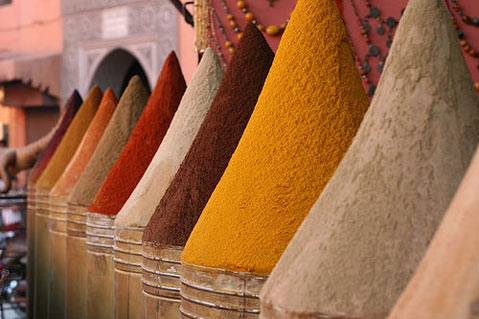Exotic Tastes
Plants that Spices Come From

Most of them began being used for preserving food or treating some human malady. Spices once served as currency and drove the spread of knowledge and commerce. The most common contents of today’s spice cabinet were rare commodities a few thousand years ago, but now they serve to season both food and drink the world over. In fact, the number of spices in common use centuries ago was probably greater than it is now.
Take black pepper. It is the unripe fruit (actually a berry) of Piper nigrum, a vine native to Madagascar, southern India, and Sri Lanka. Dried and ground, it is the most widely consumed spice in the world, with 17 percent of the population enjoying its heat. There are other Piper relatives that spice up food, as well. P. longum, or long pepper, is from the tropical heights of the Himalayas and has its own distinctive flavor (as well as a contraceptive effect when fed to rats). P. amalgo was grown by the Aztecs and added to their chocolate. P. betle leaves are used to wrap the narcotic betel nut in India and Malaysia, and the leaves of P. sanctum flavor quesadillas and other dishes in southern Mexico, while its shoots are a vegetable in Central America. Impressive relatives to the humble “P” are on every table in America.
Cinnamon is, of course, the very outer bark of Cinnamomum verum, although some of its relatives have been passing for the same spice for years. C. aromaticum is the slightly coarser cousin that is used to flavor everything from stewed fruit to toothpaste. A few other species also find their way into aromatics in liquor, as well as medicine. And the wood, also highly aromatic, is used to ward off insects in wardrobes and cabinets.
Cumin (Cuminum cyminum) has been flavoring cakes, cheese, and more since the time of the Minoans (13th century BCE). Cloves are the dried flower buds of Syzygium aromaticum and have been around since at least 200 BCE, when courtiers in both Alexandria and China had to have them in their mouths when addressing their emperors. Nutmeg and mace come from the same tree, Myristica fragrans. Mace is the outer covering of the seed (called an aril), and nutmeg the seed itself. Brazilian nutmeg, however, is an entirely different species, Cryptocarya moschata; West African nutmeg is Monodora myristica; and Peruvian nutmeg is the seed of Laurelia sempervirens. And just what is allspice? Is it a mixture of all the above warm-flavored products? Not at all. It is the unripe fruit of Pimenta officinalis. In addition to its fragrance and spice being added to cakes and pies, it is used in the distillation of Benedictine and Chartreuse liqueurs.
Most people know that ground ginger really is just ground dried ginger root. Another gingery spice whose seeds were once used instead of black pepper is grains of paradise, Aframomum melegueta. In the same genus is cardamom, A. corrorima. Very few of these spices grow outside the tropics, and perhaps that only adds to their allure. They add a touch of warmth to otherwise cool cuisine.



